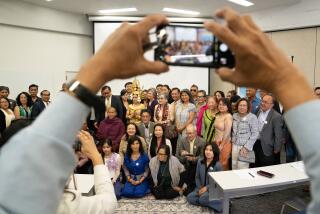Free Exhibit Explores Manifestations of the Feminine in Art From Cambodia
- Share via
There was a time when Malen Chhuon’s stomach was swollen from malnutrition. Yet although her body was starving, her spirit was being fed by a dream--that she would one day make it to the United States.
Today, that dream is a reality.
Eighteen-year-old Chhuon, who came to the United States in 1981, is one of the estimated 70,000 Cambodians who live in California. But rather than forget her roots, Chhuon, a Reseda resident who attends the Fashion Institute of Design downtown, is eager to preserve her native culture. On Sunday, she, along with other members of The Cambodian Dance and Music Project of Van Nuys, will participate in a Cambodian arts festival at the Woman’s Building in downtown Los Angeles.
As part of “Apsara: The Feminine in Cambodian Art,” a free exhibit that runs through Jan. 9, Sunday’s event will feature entertainment, food displays and craft demonstrations. Haing Ngor, Academy Award-winning star of “The Killing Fields,” is scheduled to appear as the guest of honor.
Hindu Origins
The show explores various manifestations--carvings, jewelry, dance and song--of Apsara, a female divinity that originated in Hindu mythology.
“The exhibit is about getting people to see them (Cambodians) in an artistic light, instead of a human tragedy light,” said organizer Amy Catlin, director of the Van Nuys project and research ethnomusicologist at UCLA.
Touted as “the first exhibit ever to celebrate Cambodian women artists,” Catlin says it’s a rare opportunity for Americans to enrich themselves, while learning about some of Los Angeles’ “newest refugees.”
An avid scholar of Southeast Asian cultures, Catlin helped get the Van Nuys project off the ground by drawing up a grant proposal more than two years ago. In July, 1986, the group received its first grant ($18,000) from the Folks Arts Division of the National Endowment for the Arts. The grant was renewed in July this year.
As part of the project, classical and folk dance lessons and rehearsals for various performances are held three to four times each week. About 25 dancers, ranging in age from 3 through their late 20s, are taught by instructors Sophanary Ouk and Khon Siv, and apprentice Savoeun Men.
During Cambodia’s notorious Pol Pot regime, Ouk, now 24, was hired to transcribe propaganda songs from the radio and teach them to children. At that time, Catlin explained, classical dance was forbidden. Instead, dance movements glorified war and work--imitating the act of shooting a gun or digging a field.
But while she was living in a refugee camp at Khao I Dang, Thailand, Ouk, who came to the United States in 1981, met up with dance teachers and received what Catlin calls “crash courses” in Cambodian classical dance--a highly stylized form of movement.
Even in today’s Cambodian dance and music, certain elements can be traced at least 1,000 years, Catlin said, although, over time, changes have inevitably evolved in movements, costumes and makeup.
Whereas in the past this art form was a symbol of royalty, reserved for the Cambodian rich, Catlin said, “now the dance is an expression of their cultural identity and a way of communicating on an artistic level with non-Cambodians.”
“It’s very therapeutic for them,” said Catlin, who noted that the dancers will begin dressing at 5 a.m. Sunday because their costumes and makeup are so elaborate.
Performances at the Woman’s Building Gallery are scheduled every hour beginning at 1 p.m. The Apsara Dance--in mythology, the Apsara statue comes to life and dances--will be performed as the finale at 4:30.
Musical accompaniment will be provided by Prahlung Khmer, “The Spirit of Cambodia,” an ensemble of 15 musicians who play an assortment of traditional instruments, including the roneat (xylophone), the takkei (plucked zither), the tro (fiddle) and the kim (hammered dulcimer). Their repertoire includes music for weddings, classical and folk dance, folk opera and humorous dialogue songs called ayay .
“The Cambodians have a very earthy sense of humor,” Catlin said. “In the ayay, the singers make up sarcastic poetry. The men and women compliment one another and then follow this with mockery. For example, a woman might say, ‘You’re a very good-looking man--but why are your nostrils bigger than your eyes?’ He might retort, ‘And you are a beautiful woman--but must you wear pounds of makeup on your face?’ ”
The Apsara exhibit will be at the Anthropology Museum at California State University, Northridge starting Feb. 1 through May 15.
More to Read
The biggest entertainment stories
Get our big stories about Hollywood, film, television, music, arts, culture and more right in your inbox as soon as they publish.
You may occasionally receive promotional content from the Los Angeles Times.










